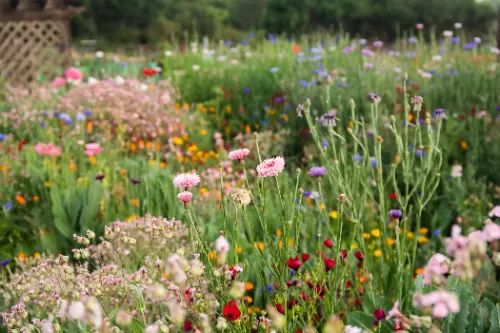

Click to Get Big Benefits

What is Wild Gardening, Anyway?
Wild gardening is the art (and joy) of embracing natural growth patterns rather than forcing a landscape into clean rows and tidy shapes. It means planting native species, allowing volunteers (aka: self-seeded plants) to stay, and designing with ecosystems in mind. Think less hedge trimmer, more pollinator haven. Unlike traditional gardening, which often relies on imported plants and constant upkeep, wild gardening is about sustainability, biodiversity, and letting the land express itself. It’s an approach where weeds might be wildflowers and the chaos is part of the charm.
Why Go Wild?
Beyond the dreamy visuals of tangled vines and swaying grasses, wild gardening serves a greater purpose. Native plants support native wildlife—bees, birds, butterflies, and countless unseen insects that keep ecosystems humming. A wild yard requires less water, fewer chemicals, and far less time than a traditional lawn. It's climate-resilient, cost-efficient, and deeply rewarding. And in a world grappling with habitat loss and ecological imbalance, wild gardening is more than a personal choice—it’s a gentle form of environmental activism, right outside your back door.
Start with the Soil
You don’t need to bulldoze your backyard to go wild. Start by observing what’s already growing. Are there native wildflowers sneaking up along your fence? Let them stay. Replace part of your lawn with a no-mow area. Scatter native wildflower seeds in the fall or early spring. Build soil health with compost and mulch rather than synthetic fertilizers. And then… wait. Wild gardening rewards patience. You’ll notice birds returning, bugs bustling, and the quiet rhythm of a landscape beginning to breathe on its own again. It’s a process—organic in every sense of the word.
Plant with Purpose, Not Perfection
Contrary to what the term might suggest, wild gardens aren’t completely random. A truly successful wild garden requires intention—choosing the right plants for your region, your soil, and the creatures you want to support. Native milkweed for monarch butterflies. Coneflowers and bee balm for pollinators. Grasses like little bluestem to anchor the landscape. Skip the exotics and nursery hybrids—go local. And embrace the odd shapes, the leaning stems, the unruly abundance. A wild garden should feel alive and a little untamed, not clipped into submission.
The Wildlife Will Thank You
One of the most magical parts of wild gardening is how quickly the creatures return. Hummingbirds zipping to the salvia. Rabbits darting through goldenrod. Fireflies blinking in the tall grasses. A single patch of native asters can become an ecosystem of its own. Wild gardens become living theaters, filled with tiny dramas—courtships, chases, quiet naps in the shade. And in return, these creatures help maintain your garden. Birds eat pests. Bees pollinate flowers. Frogs eat mosquitoes. It’s nature’s loop, and you’re part of it now.
Yes, There Will Be Weeds – and That’s Okay
Let’s talk expectations: wild does not mean maintenance-free. Some weeds will be welcome. Others, less so. The trick is learning the difference. You’ll want to manage invasives that outcompete everything else (we’re looking at you, English ivy and Japanese honeysuckle). But that scraggly plant you thought was a weed? It might be the host plant for a rare butterfly. Get familiar with your local flora. Join a native plant society or online group. Learn to see beauty in resilience and surprise in the so-called “mess.” Wild gardening is as much about observation as action.
Designing for Delight
Even wildness benefits from a little structure. A curved path through tall grass. A small seating area tucked under a redbud tree. A stone border to give definition to a bed of native perennials. These elements give your wild garden visual coherence without robbing it of its spirit. Think of them as punctuation marks in a poem: subtle guidance, not control. Wild gardening doesn’t have to look like a vacant lot. It can look intentional, abundant, and inviting—with a healthy dose of serendipity thrown in.
The Joy of Letting Go
Perhaps the greatest gift of wild gardening is what it teaches us about letting go. Of perfection. Of control. Of the idea that nature needs us to fix it. A wild garden humbles you. You’ll watch flowers bloom and fade without ever touching them. You’ll learn that some things thrive where they’re not planted. And in time, you’ll come to see beauty in the whole cycle—from seed to decay. In a culture obsessed with doing, wild gardening invites us to pause, observe, and simply be.
Start Small, Dream Big
You don’t need ten acres to begin. Start with a corner. A container. A strip of lawn turned into a wildflower patch. Let curiosity guide you. Take photos. Keep a journal. Celebrate every new visitor, every unexpected bloom. Over time, that small patch can expand—and with it, your sense of wonder. Because wild gardening isn’t just a hobby. It’s a perspective shift. A way of seeing your yard not as a project to be controlled, but a place to be discovered. One leaf, one seed, one bird at a time.

All News
Others
- Terms of use
- Privacy Policy